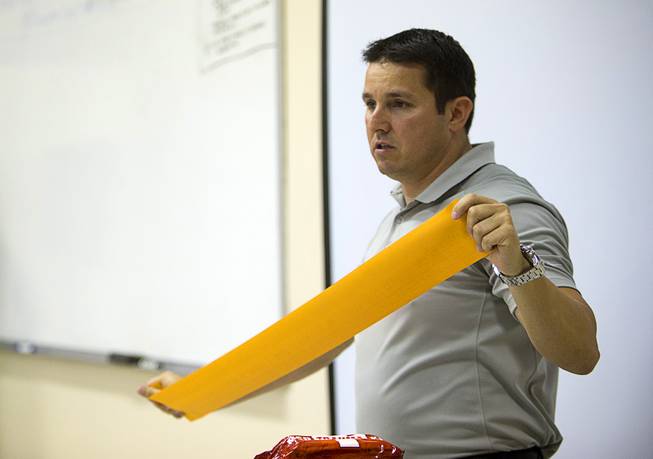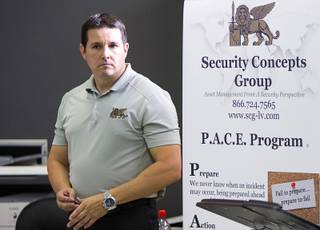
James Cameron, founder of Security Concepts Group, talks about tourniquets during an active shooter training seminar at the Red Rock Search and Rescue training center Tuesday, July 12, 2016.
Monday, July 25, 2016 | 2 a.m.
During the attack last month at Orlando nightclub Pulse, frantic shooting victims — some of whom likely bled to death — were texting their loved ones.
Mass-casualty incidents are difficult to prevent, but individuals caught in the fray can take life-saving action, says James Cameron, founder of Security Concepts Group.
“What happens if somebody is shot and you were there? What happens if it’s you?” he says.
Cameron’s Las Vegas-based company conducts active-shooter and mass-casualty training for civilians, emphasizing what he says other courses lack: medical training. The “care” portion of his PACE presentation — prepare, action, care and evacuation — teaches the use of potentially life-saving field techniques before emergency responders arrive, including stopping blood loss by applying tourniquets and pressure and packing wounds.
Cameron, 42, originally from California, joined the military after high school. He left to pursue a college education, but rejoined after 9/11. As an Army Ranger, he served in Iraq and Afghanistan, where he saw combat and experienced multiple mass-casualty situations.
After his military career, he worked overseas as a contracted security specialist for the State Department, where he says he provided protection for high-ranking diplomats, congressional leaders and ambassadors in “high-threat environments.”
He founded his security company in 2009, initially focused on providing protection for prominent figures, from executives of Fortune 500-ranked companies to Middle Eastern royalty. Not long ago, he shifted the attention to civilian training (a four-hour course runs from $150 to $200).
“Unfortunately, in this environment, active shooters and terrorist events are happening more,” Cameron said.
What was the first mass-casualty situation you found yourself in?
At about 3 p.m., May 25, 2004, mortars began to fall on Forward Operating Base Kalsu — about 20 miles south of Baghdad. Seventeen rounds of 107-mm mortars impacted our base as close as 50 meters from my location. We immediately covered and evaluated some of the areas impacted. We saw nothing but smoke and dust. This made me realize that the rounds hit closer than what I had expected. Once the attack stopped, I ran back to my tent to retrieve my trauma kit and my rack. I then ran to where I heard casualties to be and offer any assistance. ... We had 15 to 20 hurt, some with minor injuries and others with much more serious wounds. A sergeant and I started to provide medical care immediately to those who hadn’t yet been treated. Since we did not have many actual medics, we were the next highest trained and began to work on those who needed it. We helped load the patients who were not able to move. At that time we tried to get a count of how many killed and wounded in action there were. We found out that three had died.
Was it volatile day to day?
If somebody tells you they were never scared over there (in the Middle East), they’re lying. Every day was a challenge. Every day you didn’t know what could potentially happen. There would be times I’d walk to the dining facilities and mortars would come in. You go from not a care in the world to running for your life because you don’t know where that mortar is going to land. You hear them coming, but you don’t know where they’re going to come in. Every day over there, you were always nervous.
What was one of the more shocking things you remember when responding to an event?
In 2008, there was an attack at a high-end hotel in Kabul, Afghanistan. The hotel was very well-protected — barricades and armed guards. Terrorists detonated a car bomb at the gate and attackers with suicide vests entered, brandishing machine guns. We responded within five minutes. After the threats were neutralized, we assessed the victims. There was a woman who had gathered with other Western visitors, and she had a traumatic injury to her left arm — it was gone. She was bleeding out and using her right hand to eat hummus out of a bowl in the middle of the carnage. There was smoke everywhere. I couldn’t believe what we were looking at.
What is your first thought when you hear reports of a mass-casualty incident?
I wonder how many people could have been saved. There are three categories after an active-shooter or terrorist event: alive, killed and wounded. There is no category that fits the mold of people who initially survive, but then bleed to death or die from their injuries. Experts know that an average person will bleed to death within two to four minutes based on the severity of the wound — that’s two to four minutes somebody has to live or die.
First thing that goes to my mind is: Here we go again. Second is: I hope somebody there is able to help, and could my training have saved somebody?
How do you turn the fear people feel about all of this into something constructive?
You don’t have to be scared; you have to be mentally prepared that the possibility is there. If you acknowledge that the possibility is there, that allows you to start thinking about, “What am I going to do?” So, people who aren’t prepared, the people who think it can’t happen to them, those are the ones who are caught by surprise, panic, freeze and don’t respond in the proper fashion.


Join the Discussion:
Check this out for a full explanation of our conversion to the LiveFyre commenting system and instructions on how to sign up for an account.
Full comments policy